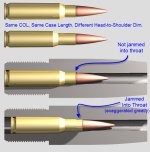stagpanther
New member
A fascinating discussion and thanks to all contributors--this is one of those instances where a Moving digram might help, at least for people like me who have trouble following exactly what's going on.
Somebody brought up AR 10 and since I've done what are referred to as high-pressure AR 10 builds--which is not to imply the routine running of charges beyond max pressure ratings for the cartridge--I thought that I might make an observation that may or may not have a bearing on the conversation. AR's don't have a firing pin spring per sae, it's more of a kinetic energy transfer from the bolt carrier to the free-floating firing pin.
I've noticed that brass in cartridges like the 6 and 6.5 creedmoors can get over-worked quickly from having to constantly set the shoulder back and then all kinds of problems can derive from that. When I switched to JP's high pressure bolts--and in particular their lighter weight and narrower-diameter firing pin--those issues were significantly alleviated.
Here is their description.
Somebody brought up AR 10 and since I've done what are referred to as high-pressure AR 10 builds--which is not to imply the routine running of charges beyond max pressure ratings for the cartridge--I thought that I might make an observation that may or may not have a bearing on the conversation. AR's don't have a firing pin spring per sae, it's more of a kinetic energy transfer from the bolt carrier to the free-floating firing pin.
I've noticed that brass in cartridges like the 6 and 6.5 creedmoors can get over-worked quickly from having to constantly set the shoulder back and then all kinds of problems can derive from that. When I switched to JP's high pressure bolts--and in particular their lighter weight and narrower-diameter firing pin--those issues were significantly alleviated.
Here is their description.

